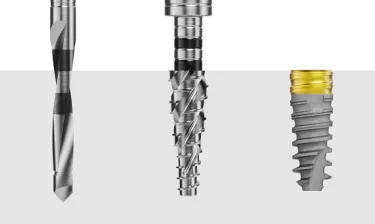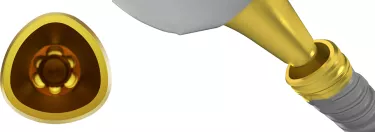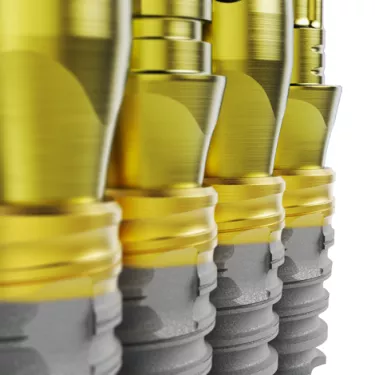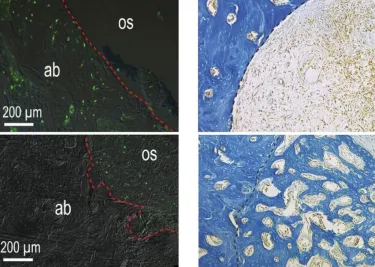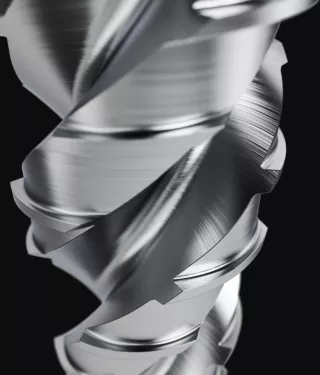
Reshaping implantology to change the way you treat patients
Nobel Biocare N1 ™ implant system
The Nobel Biocare N1 implant system is a landmark innovation created to empower clinicians with simplicity and confidence. Designed and developed by rethinking some of the fundamentals behind implantology, it is a complete system featuring new concepts in site preparation, implant macroshape, prosthetic connections, emergence profile and more, all created to support clinicians at every step. And, ultimately, to optimize the treatment experience of patients.
- 1. Reshaping implantology in just three steps: Direct – Shape – Place
- 2. Confidence for clinicians, greater comfort for patients
- 3. Stable from the start: An implant designed for immediate placement and funct…
- 4. Slide prosthetics into place, restore with confidence
- 5. Prosthetics designed to support soft tissue maintenance and esthetics
- 6. Science behind the system
- 7. Embracing the Mucointegration™ principle
Reshaping implantology in just three steps: Direct – Shape – Place
A system bringing control and simplicity to clinicians, the Nobel Biocare N1 treatment journey can be encapsulated in just three simple words. Direct. Shape. Place.
Site preparation commences with the OsseoDirector™ instrument, setting the depth and direction of the Nobel Biocare N1 Implant. With its tapered body, featuring cutting flutes with side cutting capability, it allows change in direction when creating the pilot osteotomy.1 What comes next truly makes the Nobel Biocare N1 system stand apart. The OsseoShaper™ protocol: a simplified and biologically driven site preparation technique. Replacing the conventional array of high-speed drills, the OsseoShaper instrument gently ‘shapes’ the osteotomy by rotating at a low speed – 50 rpm – and without irrigation. In doing so, it reduces heat and causes less trauma compared to high-speed drills, thereby preserving osteogenic material.2 Because of the design of this instrument, many of the bone chips produced during site preparation are also deposited into the osteotomy when the instrument is reversed.2,3 Furthermore, this instrument shapes the osteotomy to match the shape of the co-packed Nobel Biocare N1 Implant.2
A technique performed according to biological principles, more of the science behind this system is explored later in this article.
Confidence for clinicians, greater comfort for patients
As well as respecting the biology behind osseointegration, one of the OsseoShaper concept’s most prominent distinctions is the greater comfort it provides for patients during site preparation, thanks to its reduction in noise and vibration compared to conventional drilling.4 The protocol also increases time efficiency: in a survey of clinicians, over 80% of the implants were placed with as few as two site preparation steps.5 The technique can also assist decision making for the clinician.6 Torques generated using the OsseoShaper concept guide the surgical workflow, assist in bone evaluation and provide an early prediction of implant stability.7
Stable from the start: An implant designed for immediate placement and function
Engineered for implant stability and early tissue integration, the Nobel Biocare N1 Implant is optimized for immediate placement and function.8,9 Specifically made to match the shape of the site created by the OsseoShaper instrument, it has a slightly tapered body that engages well in extraction sockets.
Perhaps the most distinctive visible feature of this implant is its trioval-shaped implant neck. This design, as shown in a preclinical study, reduces stress on cortical bone and is more stable compared to a round implant, and subsequently promotes fast osseointegration.9
Slide prosthetics into place, restore with confidence
Just like the Nobel Biocare N1 Implant, the prosthetic connection features the trioval shape. This means that with the fully indexed trioval conical connection (TCC), all the prosthetic components simply slide into place. The innovative TCC adds several key benefits to this system. Firstly, the clinical screw only engages when the abutment is fully centered into the correctly seated position, helping the clinician restore with confidence. Secondly, the trioval shape ensures a 360° consistent width of the implant wall and platform shift, designed for excellent strength and soft tissue management.10 And thirdly, all TCC abutments are slim restorative components that achieve a strong and tight connection, with a torque of only 20 Ncm.10 Thanks to this smaller tightening torque,* the system features restorative components with smaller screw heads and screw channels to maximize esthetics.11
Prosthetics designed to support soft tissue maintenance and esthetics
Featuring dedicated prosthetics with optimized emergence profiles, surfaces, and trioval shapes, the Nobel Biocare N1 system showcases the wisdom of the Mucointegration™ era for soft tissue maintenance and esthetics. Nobel Biocare has taken this opportunity to design the prosthetic components from the ground up, allowing slim and harmonized emergence profiles across the whole portfolio. This slim emergence profile flares out for a smooth transition towards the crown or bridge, and it is designed to achieve generous soft tissue volume, long-term tissue stability, esthetics and restorative flexibility.
The Nobel Biocare N1 Base is a two-piece abutment placed at the time of surgery and left in situ to preserve the connective tissue structure throughout the restorative workflow, in favor of marginal bone preservation and soft tissue health.12,13 Available in three different heights, it offers flexibility over a lifetime and can be replaced without removing the full implant.
Science behind the system
On a mission to rethink implantology, this new concept originated with a research team undertaking a ‘back to basics’ approach, interrogating some fundamental biological principles.
Osseointegration is the very foundation of dental implant treatment, yet this pre-clinical research observed how conventional implant site preparation contributes to bone resorption. A clear ‘zone of death’ with dying osteocytes around the osteotomy was identified, caused by the heat and trauma of high-speed drilling.2 While irrigation is normally used to reduce heat, irrigation manifests its own drawbacks by washing away vital bone chips and osseous coagulum, which offer the osteogenic potential to stimulate bone formation and enhance the viability of the implant site.2
Four years of preclinical biological studies drove the development of the OsseoShaper concept. The site preparation protocol was designed to minimize the zone of death and to preserve osteogenic materials in and around the osteotomy. A biologically-driven design, the low-speed OsseoShaper instrument reduces heat and trauma compared to conventional high-speed drills, and eliminates the need for irrigation. As a result, pre-clinical studies have demonstrated that this site preparation concept enables earlier bone formation in the osteotomy and achieves a more viable site compared to conventional drilling protocols.2,3
Embracing the Mucointegration™ principle
The system utilizes Nobel Biocare’s latest developments in surface science with the Xeal™ abutment surface and TiUltra™ implant surface, designed to optimize tissue integration at level. The Xeal surface is available on the Nobel Biocare N1 Base and Multi-unit Abutments, possessing surface chemistry and topography specially designed to promote soft tissue attachment.14 TiUltra, featured on the N1 Implant, is an ultra-hydrophilic, multizone, anodized surface with a gradual topography from collar to apex.15,16,17
After over five years of pre-clinical research, and clinical use since 2017, every aspect of the Nobel Biocare N1 system stands out. From the way it is designed, to the way it embraces biology, to the pioneering surfaces, it is an innovation to reshape implantology for clinicians and patients.
References
- Data on file
- Chen CH, Coyac BR, Arioka M, et al. A Novel Osteotomy Preparation Technique to Preserve Implant Site Viability and Enhance Osteogenesis. J Clin Med. 2019;8(2):1-13.
Read online - Coyac, B.R.; Salvi, G; Leahy, B; Salmon, B; Hoffmann, W, Helms J., A novel system exploits bone debris for implant osseointegration. Journal of Clinical Periodontology
Read online - Zemp J, Velikov S, Weißbrot S, et al. New Low-speed Site Preparation Protocol Significantly Reduces Noise. J Dent Res. 2020;99 (Spec Iss A):3053
- Data on file
- Data on file
- Velikov S, Susin C, Heuberger P, Irastorza-Landa A. A New Site Preparation Protocol That Supports Bone Quality Evaluation and Provides Predictable Implant Insertion Torque. J Clin Med. 2020;9(2).
Read online - Velikov S, Camenzind M, Fabech J, et al. Stability of a New Trioval Implant in Bone Surrogate Model. J Dent Res. 2020;99 (Spec Iss A):3052
- Yin, X.; Li, J.; Hoffmann, W.; Gasser, A.; Brunski, J.B.; Helms, J.A. Mechanical and Biological Advantages of a Tri-Oval Implant Design. J. Clin. Med. 2019, 8, 427.
https://www.mdpi.com/2077-0383/8/4/427 - Velikov, S., Fabech, J. and Heuberger, P. (2019), Mechanical properties of a novel conical connection. Clin Oral Impl Res, 30: 216-216. doi:10.1111/clr.174_13509
Read online - Data on file
- Wang QQ, et al, One-time versus repeated abutment connection for platform-switched implant: A systematic review and meta-analysis, PLoS One 2017;12(10)
Read online - Tallarico M, et al. Definitive Abutments Placed at Implant Insertion and Never Removed: Is It an Effective Approach? A Systematic Review and Meta-Analysis of Randomized Controlled Trials;J Oral Maxillofac Sug 2018;76(2)
Read on PubMed - Susin C, Finger Stadler A, Fiorini T, et al. Safety and efficacy of a novel anodized abutment on soft tissue healing in Yucatan mini-pigs. Clin Implant Dent Relat Res 2019;21(Suppl 1):34-43.
Read online - Milleret V, Lienemann PS, Gasser A, et al. Rational design and in vitro characterization of novel dental implant and abutment surfaces for balancing clinical and biological needs. Clin Implant Dent Relat Res 2019;21(Suppl 1):15-24.
Read online - Wennerberg A, Albrektsson T, Chrcanovic B. Long-term clinical outcome of implants with different surface modifications. Eur J Oral Implantol 2018;11(Suppl 1):S123-S136.
Read online - Milleret V, Lienemann PS, Bauer S, Ehrbar M. Quantitative in vitro comparison of the thrombogenicity of commercial dental implants. Clin Implant Dent Relat Res 2019;21(Suppl 1):8-14.
Read online
